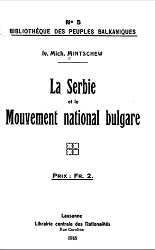
La Serbie et le Mouvement National Bulgare
published by: Librarie centrale des Nationalités, Lausanne
More...We kindly inform you that, as long as the subject affiliation of our 300.000+ articles is in progress, you might get unsufficient or no results on your third level or second level search. In this case, please broaden your search criteria.

published by: Librarie centrale des Nationalités, Lausanne
More...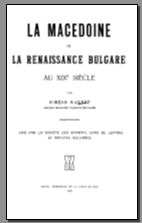
published by the Bulgarian Association of Researchers, Literates and Artists printed by the Press of the Royal Court, Sofia 1918 author's name in the French edition is written: "Radeff"
More...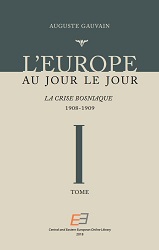
The 14 volumes of Auguste Gauvain represent an <strong>11 Years Political Diary</strong> of the very origins of Modern Europe as it evolved in early 20th century from a multitude of disintegrations (OTTOMAN EMPIRE…), competitions between colonialist powers (BERLIN-BAGDAD….), diplomatic pinpricks (AFFAIRE AGADIR….), side-theatres of war (BALKAN WARS 1912/13…) and, finally, the unique and global catastrophe of WorldWar I.<br>The idea of Modern Europe originated simultaneously from the efforts of thousands of individual politicians, diplomats, intellectuals to find applicable ways to prevent those European « Bloodlands » (<i>Timothy D. Snyder</i> ) during their own age as well as and for the future of Europe.<br>In 1908, when Austria-Hungary implemented the annexation of Bosnia-Herzegovina, the French journalist and Foreign-Policy expert Auguste Gauvain considered this decision of the Habsburg Empire as the beginning of a process which, more or less unavoidably, would result in a European War. Hence, he began writing a daily column on the “Event of the Day” in European politics for the French journal « Les Debats ». With few and short interruptions during WW I he did so on each day until the end of the Versailles Peace negotiations in 1919. In early 1920s he published the full collection of all these columns in 14 volumes with the title <strong>« L’Europe au Jour le Jour ».</strong><br>CEEOL has decided to re-publish all these 14 volumes and nearly 10.000 pages as a contemporary key document for understanding the very origins of Modern Europe, the historical progress it represents and the historical necessities and forces which triggered its development. Even its supra-national institution-building after WW II cannot be really understood without this historical background of a few decades before. <br><br><strong>FOR DETAILS REGARDING THIS VOLUME PLEASE DOWNLOAD PDFs FROM THE «Contents»-TAB HERE ↓↓ BELOW</strong>
More...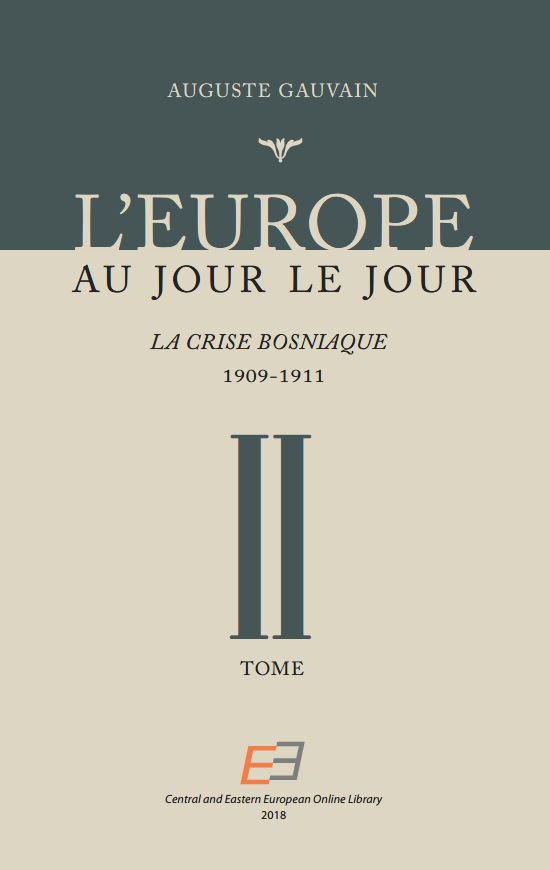
The 14 volumes of Auguste Gauvain represent an <strong>11 Years Political Diary</strong> of the very origins of Modern Europe as it evolved in early 20th century from a multitude of disintegrations (OTTOMAN EMPIRE…), competitions between colonialist powers (BERLIN-BAGDAD….), diplomatic pinpricks (AFFAIRE AGADIR….), side-theatres of war (BALKAN WARS 1912/13…) and, finally, the unique and global catastrophe of WorldWar I.<br>The idea of Modern Europe originated simultaneously from the efforts of thousands of individual politicians, diplomats, intellectuals to find applicable ways to prevent those European « Bloodlands » (<i>Timothy D. Snyder</i> ) during their own age as well as and for the future of Europe.<br>In 1908, when Austria-Hungary implemented the annexation of Bosnia-Herzegovina, the French journalist and Foreign-Policy expert Auguste Gauvain considered this decision of the Habsburg Empire as the beginning of a process which, more or less unavoidably, would result in a European War. Hence, he began writing a daily column on the “Event of the Day” in European politics for the French journal « Les Debats ». With few and short interruptions during WW I he did so on each day until the end of the Versailles Peace negotiations in 1919. In early 1920s he published the full collection of all these columns in 14 volumes with the title <strong>« L’Europe au Jour le Jour ».</strong><br>CEEOL has decided to re-publish all these 14 volumes and nearly 10.000 pages as a contemporary key document for understanding the very origins of Modern Europe, the historical progress it represents and the historical necessities and forces which triggered its development. Even its supra-national institution-building after WW II cannot be really understood without this historical background of a few decades before. <br><br><strong>FOR DETAILS REGARDING THIS VOLUME PLEASE DOWNLOAD PDFs FROM THE «Contents»-TAB HERE ↓↓ BELOW</strong>
More...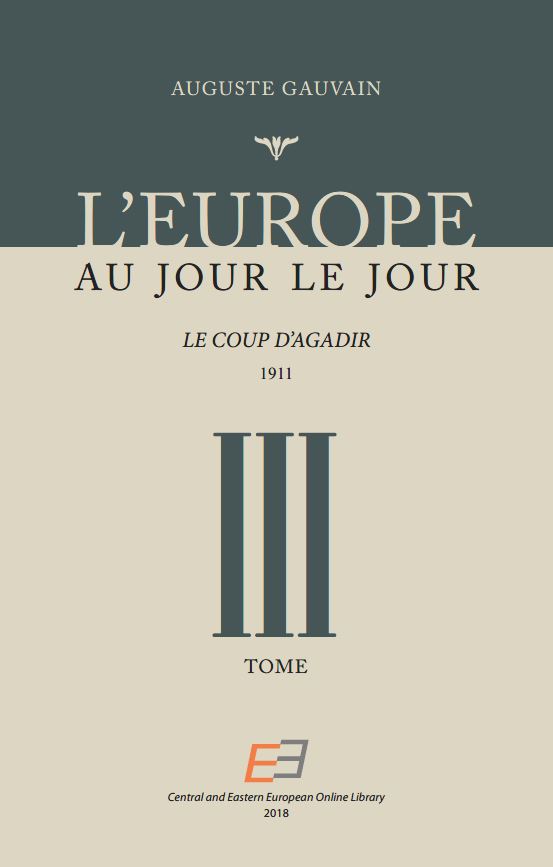
The 14 volumes of Auguste Gauvain represent an <strong>11 Years Political Diary</strong> of the very origins of Modern Europe as it evolved in early 20th century from a multitude of disintegrations (OTTOMAN EMPIRE…), competitions between colonialist powers (BERLIN-BAGDAD….), diplomatic pinpricks (AFFAIRE AGADIR….), side-theatres of war (BALKAN WARS 1912/13…) and, finally, the unique and global catastrophe of WorldWar I.<br>The idea of Modern Europe originated simultaneously from the efforts of thousands of individual politicians, diplomats, intellectuals to find applicable ways to prevent those European « Bloodlands » (<i>Timothy D. Snyder</i> ) during their own age as well as and for the future of Europe.<br>In 1908, when Austria-Hungary implemented the annexation of Bosnia-Herzegovina, the French journalist and Foreign-Policy expert Auguste Gauvain considered this decision of the Habsburg Empire as the beginning of a process which, more or less unavoidably, would result in a European War. Hence, he began writing a daily column on the “Event of the Day” in European politics for the French journal « Les Debats ». With few and short interruptions during WW I he did so on each day until the end of the Versailles Peace negotiations in 1919. In early 1920s he published the full collection of all these columns in 14 volumes with the title <strong>« L’Europe au Jour le Jour ».</strong><br>CEEOL has decided to re-publish all these 14 volumes and nearly 10.000 pages as a contemporary key document for understanding the very origins of Modern Europe, the historical progress it represents and the historical necessities and forces which triggered its development. Even its supra-national institution-building after WW II cannot be really understood without this historical background of a few decades before. <br><br><strong>FOR DETAILS REGARDING THIS VOLUME PLEASE DOWNLOAD PDFs FROM THE «Contents»-TAB HERE ↓↓ BELOW</strong>
More...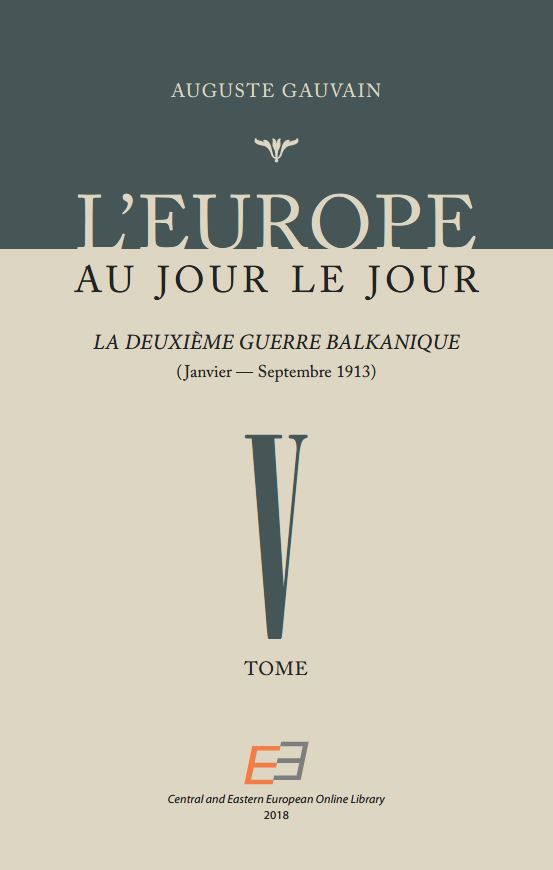
The 14 volumes of Auguste Gauvain represent an <strong>11 Years Political Diary</strong> of the very origins of Modern Europe as it evolved in early 20th century from a multitude of disintegrations (OTTOMAN EMPIRE…), competitions between colonialist powers (BERLIN-BAGDAD….), diplomatic pinpricks (AFFAIRE AGADIR….), side-theatres of war (BALKAN WARS 1912/13…) and, finally, the unique and global catastrophe of WorldWar I.<br>The idea of Modern Europe originated simultaneously from the efforts of thousands of individual politicians, diplomats, intellectuals to find applicable ways to prevent those European « Bloodlands » (<i>Timothy D. Snyder</i> ) during their own age as well as and for the future of Europe.<br>In 1908, when Austria-Hungary implemented the annexation of Bosnia-Herzegovina, the French journalist and Foreign-Policy expert Auguste Gauvain considered this decision of the Habsburg Empire as the beginning of a process which, more or less unavoidably, would result in a European War. Hence, he began writing a daily column on the “Event of the Day” in European politics for the French journal « Les Debats ». With few and short interruptions during WW I he did so on each day until the end of the Versailles Peace negotiations in 1919. In early 1920s he published the full collection of all these columns in 14 volumes with the title <strong>« L’Europe au Jour le Jour ».</strong><br>CEEOL has decided to re-publish all these 14 volumes and nearly 10.000 pages as a contemporary key document for understanding the very origins of Modern Europe, the historical progress it represents and the historical necessities and forces which triggered its development. Even its supra-national institution-building after WW II cannot be really understood without this historical background of a few decades before. <br><br><strong>FOR DETAILS REGARDING THIS VOLUME PLEASE DOWNLOAD PDFs FROM THE «Contents»-TAB HERE ↓↓ BELOW</strong>
More...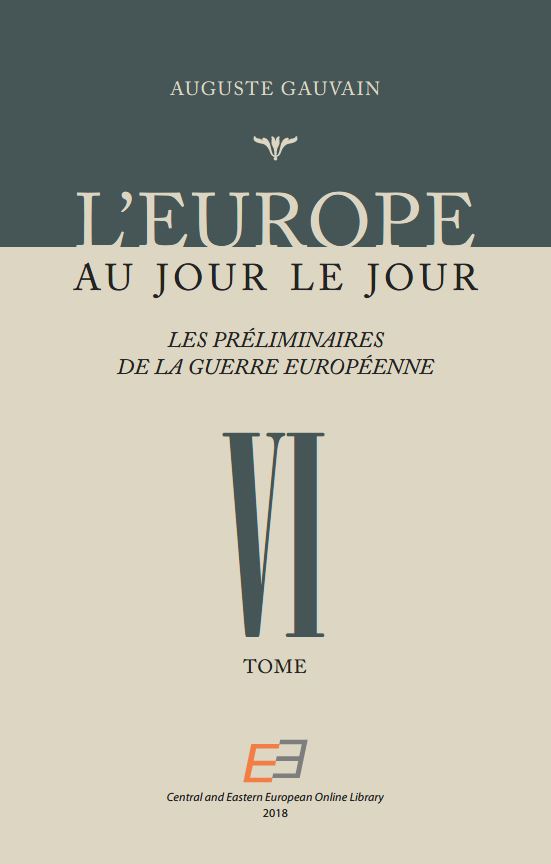
The 14 volumes of Auguste Gauvain represent an <strong>11 Years Political Diary</strong> of the very origins of Modern Europe as it evolved in early 20th century from a multitude of disintegrations (OTTOMAN EMPIRE…), competitions between colonialist powers (BERLIN-BAGDAD….), diplomatic pinpricks (AFFAIRE AGADIR….), side-theatres of war (BALKAN WARS 1912/13…) and, finally, the unique and global catastrophe of WorldWar I.<br>The idea of Modern Europe originated simultaneously from the efforts of thousands of individual politicians, diplomats, intellectuals to find applicable ways to prevent those European « Bloodlands » (<i>Timothy D. Snyder</i> ) during their own age as well as and for the future of Europe.<br>In 1908, when Austria-Hungary implemented the annexation of Bosnia-Herzegovina, the French journalist and Foreign-Policy expert Auguste Gauvain considered this decision of the Habsburg Empire as the beginning of a process which, more or less unavoidably, would result in a European War. Hence, he began writing a daily column on the “Event of the Day” in European politics for the French journal « Les Debats ». With few and short interruptions during WW I he did so on each day until the end of the Versailles Peace negotiations in 1919. In early 1920s he published the full collection of all these columns in 14 volumes with the title <strong>« L’Europe au Jour le Jour ».</strong><br>CEEOL has decided to re-publish all these 14 volumes and nearly 10.000 pages as a contemporary key document for understanding the very origins of Modern Europe, the historical progress it represents and the historical necessities and forces which triggered its development. Even its supra-national institution-building after WW II cannot be really understood without this historical background of a few decades before. <br><br><strong>FOR DETAILS REGARDING THIS VOLUME PLEASE DOWNLOAD PDFs FROM THE «Contents»-TAB HERE ↓↓ BELOW</strong>
More...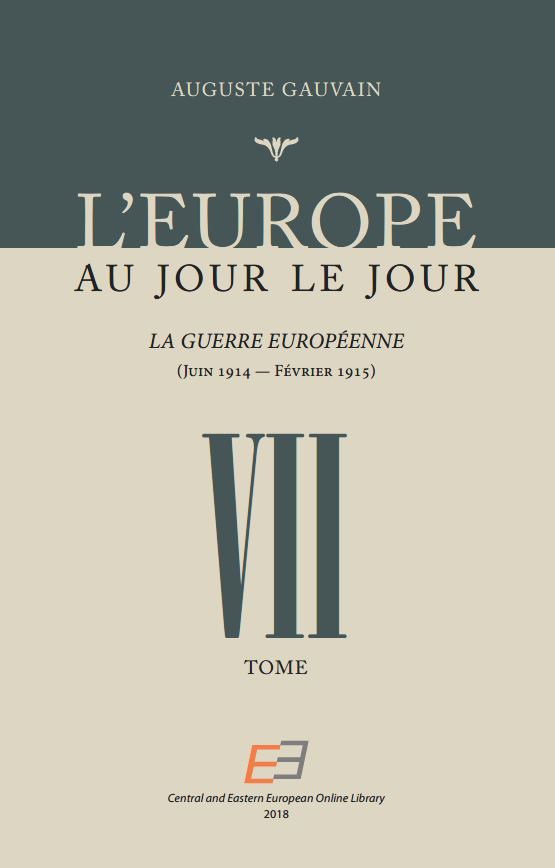
The 14 volumes of Auguste Gauvain represent an <strong>11 Years Political Diary</strong> of the very origins of Modern Europe as it evolved in early 20th century from a multitude of disintegrations (OTTOMAN EMPIRE…), competitions between colonialist powers (BERLIN-BAGDAD….), diplomatic pinpricks (AFFAIRE AGADIR….), side-theatres of war (BALKAN WARS 1912/13…) and, finally, the unique and global catastrophe of WorldWar I.<br>The idea of Modern Europe originated simultaneously from the efforts of thousands of individual politicians, diplomats, intellectuals to find applicable ways to prevent those European « Bloodlands » (<i>Timothy D. Snyder</i> ) during their own age as well as and for the future of Europe.<br>In 1908, when Austria-Hungary implemented the annexation of Bosnia-Herzegovina, the French journalist and Foreign-Policy expert Auguste Gauvain considered this decision of the Habsburg Empire as the beginning of a process which, more or less unavoidably, would result in a European War. Hence, he began writing a daily column on the “Event of the Day” in European politics for the French journal « Les Debats ». With few and short interruptions during WW I he did so on each day until the end of the Versailles Peace negotiations in 1919. In early 1920s he published the full collection of all these columns in 14 volumes with the title <strong>« L’Europe au Jour le Jour ».</strong><br>CEEOL has decided to re-publish all these 14 volumes and nearly 10.000 pages as a contemporary key document for understanding the very origins of Modern Europe, the historical progress it represents and the historical necessities and forces which triggered its development. Even its supra-national institution-building after WW II cannot be really understood without this historical background of a few decades before. <br><br><strong>FOR DETAILS REGARDING THIS VOLUME PLEASE DOWNLOAD PDFs FROM THE «Contents»-TAB HERE ↓↓ BELOW</strong>
More...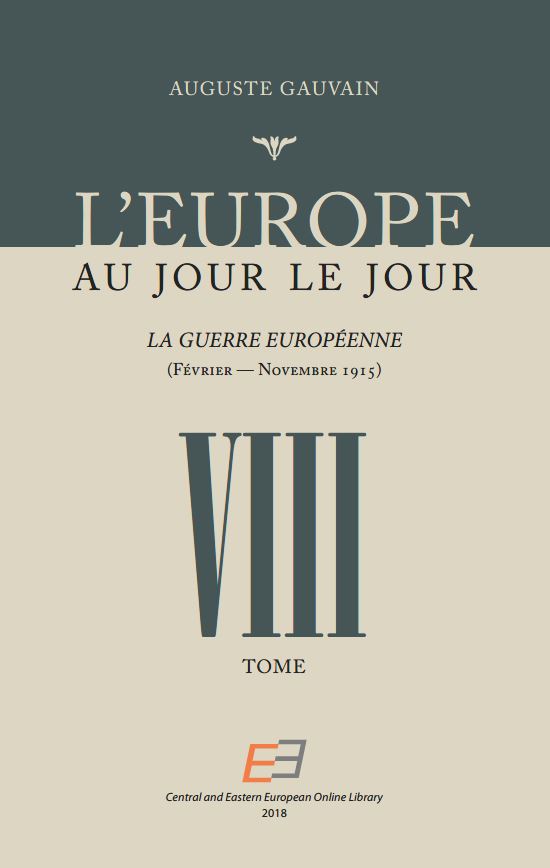
The 14 volumes of Auguste Gauvain represent an <strong>11 Years Political Diary</strong> of the very origins of Modern Europe as it evolved in early 20th century from a multitude of disintegrations (OTTOMAN EMPIRE…), competitions between colonialist powers (BERLIN-BAGDAD….), diplomatic pinpricks (AFFAIRE AGADIR….), side-theatres of war (BALKAN WARS 1912/13…) and, finally, the unique and global catastrophe of WorldWar I.<br>The idea of Modern Europe originated simultaneously from the efforts of thousands of individual politicians, diplomats, intellectuals to find applicable ways to prevent those European « Bloodlands » (<i>Timothy D. Snyder</i> ) during their own age as well as and for the future of Europe.<br>In 1908, when Austria-Hungary implemented the annexation of Bosnia-Herzegovina, the French journalist and Foreign-Policy expert Auguste Gauvain considered this decision of the Habsburg Empire as the beginning of a process which, more or less unavoidably, would result in a European War. Hence, he began writing a daily column on the “Event of the Day” in European politics for the French journal « Les Debats ». With few and short interruptions during WW I he did so on each day until the end of the Versailles Peace negotiations in 1919. In early 1920s he published the full collection of all these columns in 14 volumes with the title <strong>« L’Europe au Jour le Jour ».</strong><br>CEEOL has decided to re-publish all these 14 volumes and nearly 10.000 pages as a contemporary key document for understanding the very origins of Modern Europe, the historical progress it represents and the historical necessities and forces which triggered its development. Even its supra-national institution-building after WW II cannot be really understood without this historical background of a few decades before. <br><br><strong>FOR DETAILS REGARDING THIS VOLUME PLEASE DOWNLOAD PDFs FROM THE «Contents»-TAB HERE ↓↓ BELOW</strong>
More...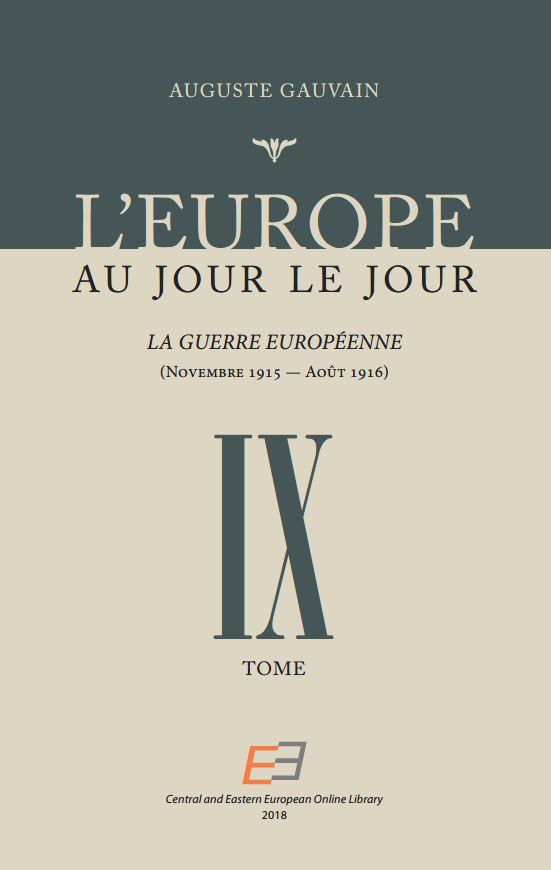
The 14 volumes of Auguste Gauvain represent an <strong>11 Years Political Diary</strong> of the very origins of Modern Europe as it evolved in early 20th century from a multitude of disintegrations (OTTOMAN EMPIRE…), competitions between colonialist powers (BERLIN-BAGDAD….), diplomatic pinpricks (AFFAIRE AGADIR….), side-theatres of war (BALKAN WARS 1912/13…) and, finally, the unique and global catastrophe of WorldWar I.<br>The idea of Modern Europe originated simultaneously from the efforts of thousands of individual politicians, diplomats, intellectuals to find applicable ways to prevent those European « Bloodlands » (<i>Timothy D. Snyder</i> ) during their own age as well as and for the future of Europe.<br>In 1908, when Austria-Hungary implemented the annexation of Bosnia-Herzegovina, the French journalist and Foreign-Policy expert Auguste Gauvain considered this decision of the Habsburg Empire as the beginning of a process which, more or less unavoidably, would result in a European War. Hence, he began writing a daily column on the “Event of the Day” in European politics for the French journal « Les Debats ». With few and short interruptions during WW I he did so on each day until the end of the Versailles Peace negotiations in 1919. In early 1920s he published the full collection of all these columns in 14 volumes with the title <strong>« L’Europe au Jour le Jour ».</strong><br>CEEOL has decided to re-publish all these 14 volumes and nearly 10.000 pages as a contemporary key document for understanding the very origins of Modern Europe, the historical progress it represents and the historical necessities and forces which triggered its development. Even its supra-national institution-building after WW II cannot be really understood without this historical background of a few decades before. <br><br><strong>FOR DETAILS REGARDING THIS VOLUME PLEASE DOWNLOAD PDFs FROM THE «Contents»-TAB HERE ↓↓ BELOW</strong>
More...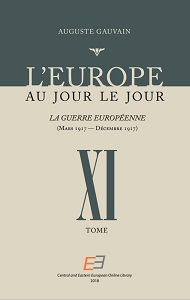
The 14 volumes of Auguste Gauvain represent an <strong>11 Years Political Diary</strong> of the very origins of Modern Europe as it evolved in early 20th century from a multitude of disintegrations (OTTOMAN EMPIRE…), competitions between colonialist powers (BERLIN-BAGDAD….), diplomatic pinpricks (AFFAIRE AGADIR….), side-theatres of war (BALKAN WARS 1912/13…) and, finally, the unique and global catastrophe of WorldWar I.<br>The idea of Modern Europe originated simultaneously from the efforts of thousands of individual politicians, diplomats, intellectuals to find applicable ways to prevent those European « Bloodlands » (<i>Timothy D. Snyder</i> ) during their own age as well as and for the future of Europe.<br>In 1908, when Austria-Hungary implemented the annexation of Bosnia-Herzegovina, the French journalist and Foreign-Policy expert Auguste Gauvain considered this decision of the Habsburg Empire as the beginning of a process which, more or less unavoidably, would result in a European War. Hence, he began writing a daily column on the “Event of the Day” in European politics for the French journal « Les Debats ». With few and short interruptions during WW I he did so on each day until the end of the Versailles Peace negotiations in 1919. In early 1920s he published the full collection of all these columns in 14 volumes with the title <strong>« L’Europe au Jour le Jour ».</strong><br>CEEOL has decided to re-publish all these 14 volumes and nearly 10.000 pages as a contemporary key document for understanding the very origins of Modern Europe, the historical progress it represents and the historical necessities and forces which triggered its development. Even its supra-national institution-building after WW II cannot be really understood without this historical background of a few decades before. <br><br><strong>FOR DETAILS REGARDING THIS VOLUME PLEASE DOWNLOAD PDFs FROM THE «Contents»-TAB HERE ↓↓ BELOW</strong>
More...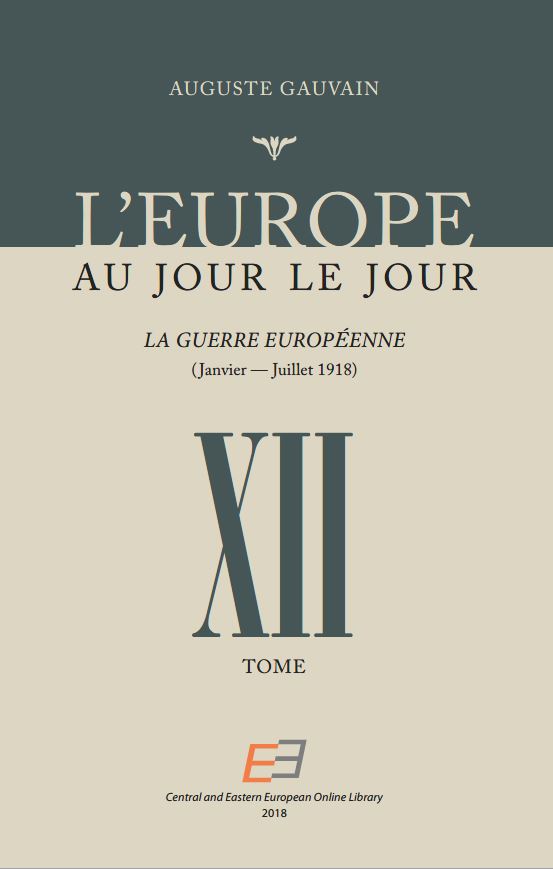
The 14 volumes of Auguste Gauvain represent an <strong>11 Years Political Diary</strong> of the very origins of Modern Europe as it evolved in early 20th century from a multitude of disintegrations (OTTOMAN EMPIRE…), competitions between colonialist powers (BERLIN-BAGDAD….), diplomatic pinpricks (AFFAIRE AGADIR….), side-theatres of war (BALKAN WARS 1912/13…) and, finally, the unique and global catastrophe of WorldWar I.<br>The idea of Modern Europe originated simultaneously from the efforts of thousands of individual politicians, diplomats, intellectuals to find applicable ways to prevent those European « Bloodlands » (<i>Timothy D. Snyder</i> ) during their own age as well as and for the future of Europe.<br>In 1908, when Austria-Hungary implemented the annexation of Bosnia-Herzegovina, the French journalist and Foreign-Policy expert Auguste Gauvain considered this decision of the Habsburg Empire as the beginning of a process which, more or less unavoidably, would result in a European War. Hence, he began writing a daily column on the “Event of the Day” in European politics for the French journal « Les Debats ». With few and short interruptions during WW I he did so on each day until the end of the Versailles Peace negotiations in 1919. In early 1920s he published the full collection of all these columns in 14 volumes with the title <strong>« L’Europe au Jour le Jour ».</strong><br>CEEOL has decided to re-publish all these 14 volumes and nearly 10.000 pages as a contemporary key document for understanding the very origins of Modern Europe, the historical progress it represents and the historical necessities and forces which triggered its development. Even its supra-national institution-building after WW II cannot be really understood without this historical background of a few decades before. <br><br><strong>FOR DETAILS REGARDING THIS VOLUME PLEASE DOWNLOAD PDFs FROM THE «Contents»-TAB HERE ↓↓ BELOW</strong>
More...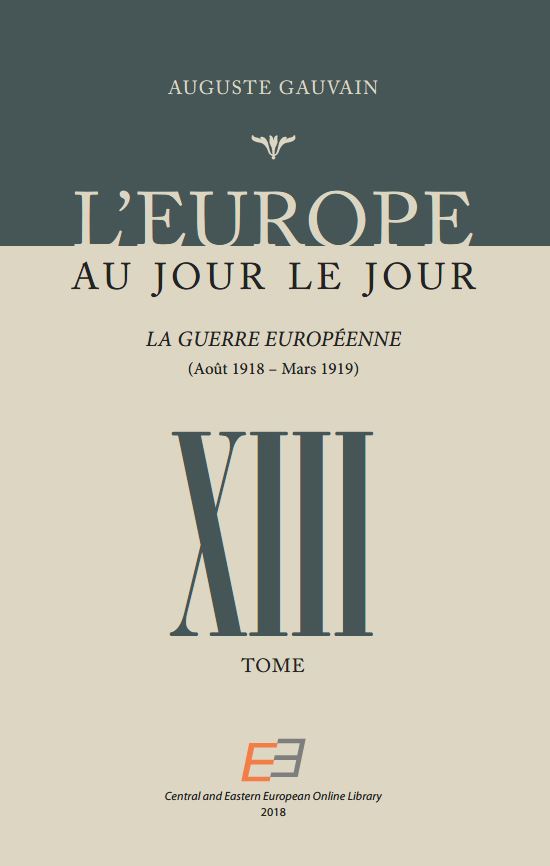
The 14 volumes of Auguste Gauvain represent an <strong>11 Years Political Diary</strong> of the very origins of Modern Europe as it evolved in early 20th century from a multitude of disintegrations (OTTOMAN EMPIRE…), competitions between colonialist powers (BERLIN-BAGDAD….), diplomatic pinpricks (AFFAIRE AGADIR….), side-theatres of war (BALKAN WARS 1912/13…) and, finally, the unique and global catastrophe of WorldWar I.<br>The idea of Modern Europe originated simultaneously from the efforts of thousands of individual politicians, diplomats, intellectuals to find applicable ways to prevent those European « Bloodlands » (<i>Timothy D. Snyder</i> ) during their own age as well as and for the future of Europe.<br>In 1908, when Austria-Hungary implemented the annexation of Bosnia-Herzegovina, the French journalist and Foreign-Policy expert Auguste Gauvain considered this decision of the Habsburg Empire as the beginning of a process which, more or less unavoidably, would result in a European War. Hence, he began writing a daily column on the “Event of the Day” in European politics for the French journal « Les Debats ». With few and short interruptions during WW I he did so on each day until the end of the Versailles Peace negotiations in 1919. In early 1920s he published the full collection of all these columns in 14 volumes with the title <strong>« L’Europe au Jour le Jour ».</strong><br>CEEOL has decided to re-publish all these 14 volumes and nearly 10.000 pages as a contemporary key document for understanding the very origins of Modern Europe, the historical progress it represents and the historical necessities and forces which triggered its development. Even its supra-national institution-building after WW II cannot be really understood without this historical background of a few decades before. <br><br><strong>FOR DETAILS REGARDING THIS VOLUME PLEASE DOWNLOAD PDFs FROM THE «Contents»-TAB HERE ↓↓ BELOW</strong>
More...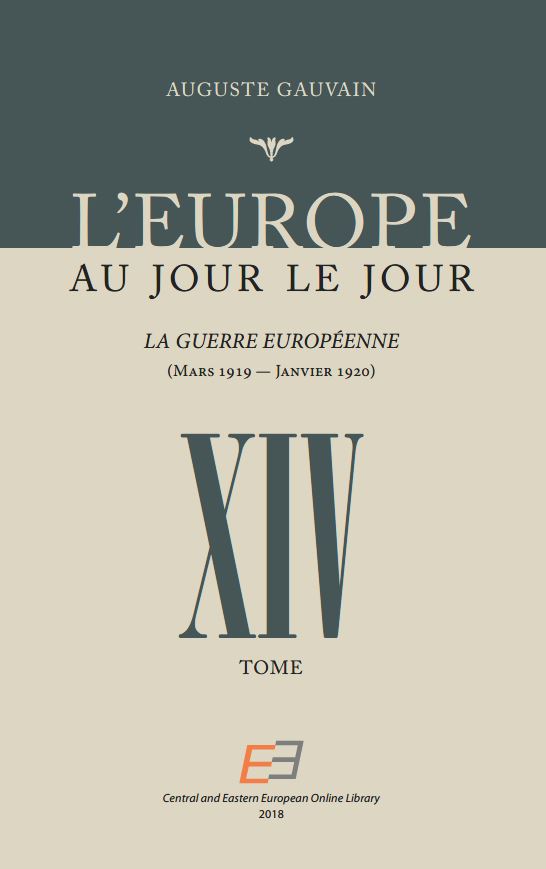
The 14 volumes of Auguste Gauvain represent an <strong>11 Years Political Diary</strong> of the very origins of Modern Europe as it evolved in early 20th century from a multitude of disintegrations (OTTOMAN EMPIRE…), competitions between colonialist powers (BERLIN-BAGDAD….), diplomatic pinpricks (AFFAIRE AGADIR….), side-theatres of war (BALKAN WARS 1912/13…) and, finally, the unique and global catastrophe of WorldWar I.<br>The idea of Modern Europe originated simultaneously from the efforts of thousands of individual politicians, diplomats, intellectuals to find applicable ways to prevent those European « Bloodlands » (<i>Timothy D. Snyder</i> ) during their own age as well as and for the future of Europe.<br>In 1908, when Austria-Hungary implemented the annexation of Bosnia-Herzegovina, the French journalist and Foreign-Policy expert Auguste Gauvain considered this decision of the Habsburg Empire as the beginning of a process which, more or less unavoidably, would result in a European War. Hence, he began writing a daily column on the “Event of the Day” in European politics for the French journal « Les Debats ». With few and short interruptions during WW I he did so on each day until the end of the Versailles Peace negotiations in 1919. In early 1920s he published the full collection of all these columns in 14 volumes with the title <strong>« L’Europe au Jour le Jour ».</strong><br>CEEOL has decided to re-publish all these 14 volumes and nearly 10.000 pages as a contemporary key document for understanding the very origins of Modern Europe, the historical progress it represents and the historical necessities and forces which triggered its development. Even its supra-national institution-building after WW II cannot be really understood without this historical background of a few decades before. <br><br><strong>FOR DETAILS REGARDING THIS VOLUME PLEASE DOWNLOAD PDFs FROM THE «Contents»-TAB HERE ↓↓ BELOW</strong>
More...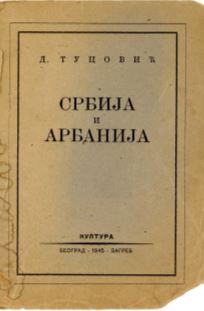
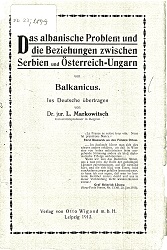
German edition published in 1913 under the pseudonym „Balkanicus“ by Otto Wigand mbH, Leipzig The booklet offers two essays of Stojan Protić who, after WW I, became the first Prime-Minister of Yugoslavia.
More...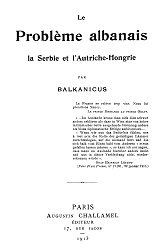
French edition published in 1913 under the pseudonym „Balkanicus“ by Augustin Challamel Editeur, Paris The booklet offers two essays of Stojan Protić who, after WW I, became the first Prime-Minister of Yugoslavia.
More...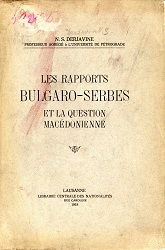
The Macedonian question arose on the day when European diplomacy at the Congress of Berlin (1878) replaced Macedonia under the authority of the Sultan, which, by the Treaty of San Stefano, was included in the Bulgarian state. Since then much has been written on this question and on the dispute between Bulgarians and Serbs, the former wanting to maintain their national unity in the cultural field and pursuing the achievement of political unity and the Serbs seeking to expand at the expense of their neighbors from the east. (introduction by the translator)
More...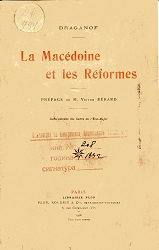
Published in 1906 by Librairie Plon in Paris. // Authors preface: "This is the full story of Macedonia and the reforms over the past ten years: on the one hand, the suffering and heroic struggles of the Macedonian people; on the other hand, the desperate efforts of the Sultan to keep under the knife this people which his brothers of Bulgaria, Serbia, Rumania and Greece civilized by the schools, but which they are unable to deliver by arms, less for lack of a military power, which would induce the end of the Ottoman rule, than for lack of a diplomatic agreement, which would combine all the interests and all the efforts in the service of civilization and liberty."
More...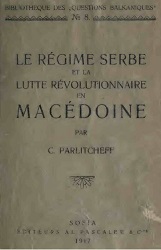
Published in 1917 by Pascalew Publisher in Sofia in the series „Bibliothèque des "Questions balkaniques", printed by the Royal Printing Press. // The author: A large number of scholars, travelers, geographers, ethnographers, historians and European publicists from both opposing camps have spoken out, during the last century and before the Balkan wars, on the ethnographic character of Macedonia. Almost all come to the conclusion that Macedonia is a country inhabited mainly by Bulgarians (in addition to Turks and Jews). The Ottoman Imperial Firman which sanctioned the restoration of the Bulgarian National Church, as well as international solemn acts, such as the Conference of Ambassadors in Constantinople, the Treaty of San Stefano and that of Berlin - confirmed this great truth. // Without dwelling on this question, we had to note this fact incidentally by exposing the factual situation, as it was under the Serbian regime and during the revolutionary struggle of the population in Macedonia during the period which embraces the end of the year 1912, when the Serbs had occupied the country, until the end of 1915, when the latter, having lost their former territory, had even had to abandon Macedonia. // Indeed, what did Macedonia represent when the Serbs, albeit for a period of three years, were the masters in this country?
More...